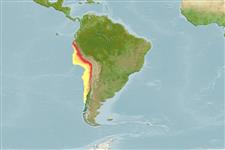Environment: milieu / climate zone / depth range / distribution range
Ecologia
marino; oceanodromo; distribuzione batimetrica 3 - 80 m. Subtropical; 13°C - 23°C (Ref. 6); 5°S - 43°S, 82°W - 69°W (Ref. 54434)
Southeast Pacific: Aguja Point, Peru to Chiloé, Chile (distribution dependent on the coastal extent of the Peru Current).
Length at first maturity / Size / Peso / Age
Maturity: Lm 12.0, range 10 - 12.5 cm
Max length : 20.0 cm SL maschio/sesso non determinato; (Ref. 189); common length : 14.0 cm TL maschio/sesso non determinato; (Ref. 5504); Età massima riportata: 3.00 anni (Ref. 189)
Spine dorsali (totale): 0; Spine anali 0. Body elongate, slender, and rounded in cross section; snout long and prominent; lower branch of first gill arch with 34 to 49 gill rakers; anal fin with fewer than 22 rays, located behind dorsal fin base; body shiny blue or green (Ref. 55763). There is a silver stripe along flank in juveniles which disappears with age. The high number of gill rakers distinguishes it from all Pacific species of Anchoa.
Adults occur mainly within 80 km of coast, forming huge schools, chiefly in surface waters. Are filter-feeders entirely dependent on the rich plankton of the Peruvian Current. In some studies, diatoms constituted as much as 98% of the diet. Large populations of guano birds and pelicans also depend on this fish (Ref. 9988). Utilized as fish meal and oil (Ref. 9988).
Eggs ellipsoidal.
Whitehead, P.J.P., G.J. Nelson and T. Wongratana, 1988. FAO Species Catalogue. Vol. 7. Clupeoid fishes of the world (Suborder Clupeoidei). An annotated and illustrated catalogue of the herrings, sardines, pilchards, sprats, shads, anchovies and wolf-herrings. FAO Fish. Synop. 125(7/2):305-579. Rome: FAO. (Ref. 189)
IUCN Red List Status (Ref. 130435)
Threat to humans
Harmless
Human uses
Pesca: elevato interesse commerciale
Strumenti
Special reports
Download XML
Fonti Internet
Estimates based on models
Preferred temperature (Ref.
123201): 17 - 20.8, mean 19.7 °C (based on 10 cells).
Phylogenetic diversity index (Ref.
82804): PD
50 = 0.5020 [Uniqueness, from 0.5 = low to 2.0 = high].
Bayesian length-weight: a=0.00457 (0.00364 - 0.00574), b=3.12 (3.08 - 3.16), in cm total length, based on LWR estimates for this species (Ref.
93245).
Trophic level (Ref.
69278): 2.9 ±0.38 se; based on food items.
Generation time: 1.3 (1.1 - 1.3) years. Estimated as median ln(3)/K based on 60
growth studies.
Resilienza (Ref.
120179): Alto, tempo minimo di raddoppiamento della popolazione meno di 15 mesi (K=0.6-0.9; tm=1; tmax=3; batch fecundity > 10,000).
Prior r = 0.83, 95% CL = 0.55 - 1.25, Based on 4 stock assessments.
Fishing Vulnerability (Ref.
59153): Low vulnerability (17 of 100).
Climate Vulnerability (Ref.
125649): Moderate vulnerability (42 of 100).
Nutrients (Ref.
124155): Calcium = 233 [104, 574] mg/100g; Iron = 1.55 [0.73, 3.65] mg/100g; Protein = 18.7 [17.4, 20.0] %; Omega3 = 0.764 [0.444, 1.331] g/100g; Selenium = 16.8 [7.9, 39.6] μg/100g; VitaminA = 11 [2, 47] μg/100g; Zinc = 1.18 [0.73, 1.89] mg/100g (wet weight);
